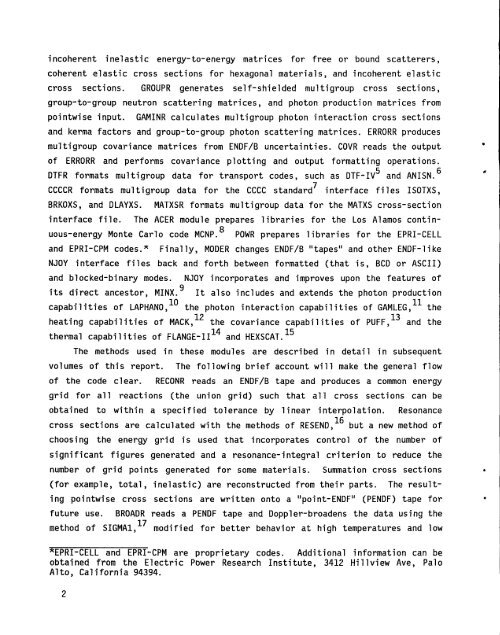The NJOY Nuclear Data Processing System, Volume 1:User's Manual
The NJOY Nuclear Data Processing System, Volume 1:User's Manual
The NJOY Nuclear Data Processing System, Volume 1:User's Manual
Create successful ePaper yourself
Turn your PDF publications into a flip-book with our unique Google optimized e-Paper software.
incoherent inelastic energy-to-energy matrices for free or bound scatterers,<br />
coherent elastic cross sections for hexagonal materials, and incoherent elastic<br />
cross sections. GROUPR generates self-shielded multigroup cross sections,<br />
group-to-group neutron scattering matrices, and photon production matrices from<br />
pointwise input. GAMINR calculates multigroup photon interaction cross sections<br />
and kerma factors and group-to-group photon scattering matrices. ERRORR produces<br />
multigroup covariance matrices from ENDF/B uncertainties. COVR reads the output<br />
of ERRORR and performs covariance plotting and output formatting operations.<br />
DTFR formats multigroup data for transport codes, such as DTF-IV5 and ANISN. 6<br />
CCCCR formats multigroup data for the CCCC standard7 interface files ISOTXS,<br />
BRKOXS, and DLAYXS. MATXSR formats multigroup data for the MATXS cross-section<br />
interface file. <strong>The</strong> ACER module prepares libraries for the Los Alamos contin-<br />
uous-energy Monte Carlo code MCNP.8 POWR prepares libraries for the EPRI-CELL<br />
and EPRI-CPM codes.* Finally, MODER changes ENDF/B “tapes” and other ENDF-like<br />
<strong>NJOY</strong> interface files back and forth between formatted (that is, BCD or ASCII)<br />
and blocked-binary modes. <strong>NJOY</strong> incorporates and improves upon the features of<br />
its direct ancestor, MINX.9 It also includes and extends the photon production<br />
capabilities of LAPHANO,1° the photon interaction capabilities of GAMLEG,ll the<br />
heating capabilities of MACK,12 the covariance capabilities of PUFF,13 and the<br />
thermal capabilities of FLANGE-1114 and HEXSCAT.15<br />
<strong>The</strong> methods used in these modules are described in detail in subsequent<br />
volumes of this report. <strong>The</strong> following brief account will make the general flow<br />
of the code clear. RECONR reads an ENDF/B tape and produces a common energy<br />
grid for all reactions (the union grid) such that all cross sections can be<br />
obtained to within a specified tolerance by linear interpolation. Resonance<br />
cross sections are calculated with the methods of RESEND,16 but a new method of<br />
choosing the energy grid is used that incorporates control of the number of<br />
significant figures generated and a resonance-integral criterion to reduce the<br />
number of grid points generated for some materials. Summation cross sections<br />
(for example, total,<br />
ing pointwise cross<br />
future use. BROADR<br />
method of SIGMA1,17<br />
inelastic) are reconstructed from their parts. <strong>The</strong> result-<br />
sections are<br />
reads a PENDF<br />
modified for<br />
written onto a “point-ENDF” (PENDF) tape for<br />
tape and Doppler-broadens the data using the<br />
better behavior at high temperatures and low<br />
*EPRI-CELL and EPRI-CPM are proprietary codes. Additional information can be<br />
obtained from the Electric Phwer Rese~rch Institute, 3412 Hillview Ave, Palo<br />
Alto, California 94394.<br />
2<br />
●<br />
●
















